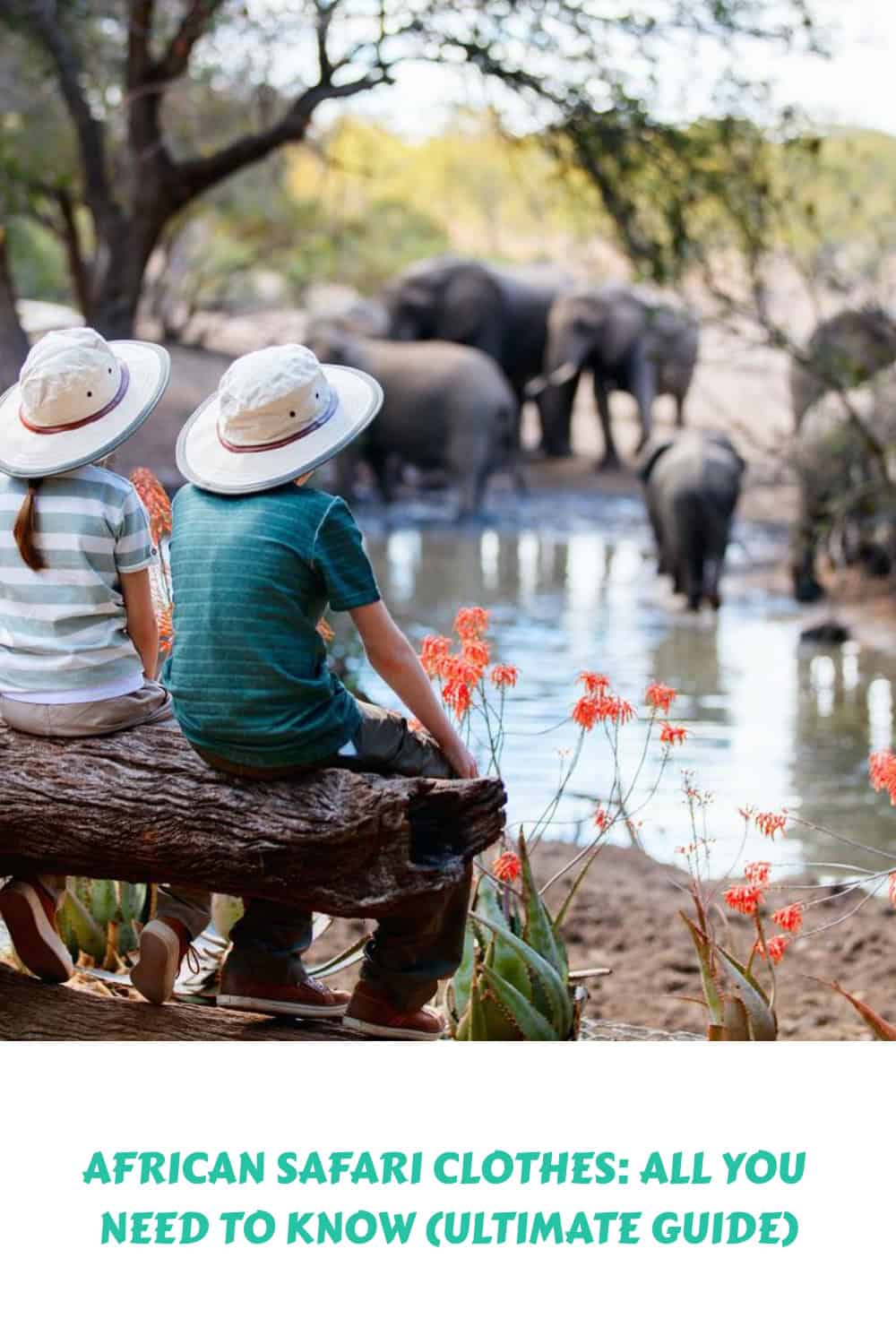Choosing the right African safari clothes is crucial for both comfort and practicality for you to get the most out of your epic adventure.
As you prepare for this adventure, remember that the key components of your wardrobe should be lightweight, breathable, and neutral colors.
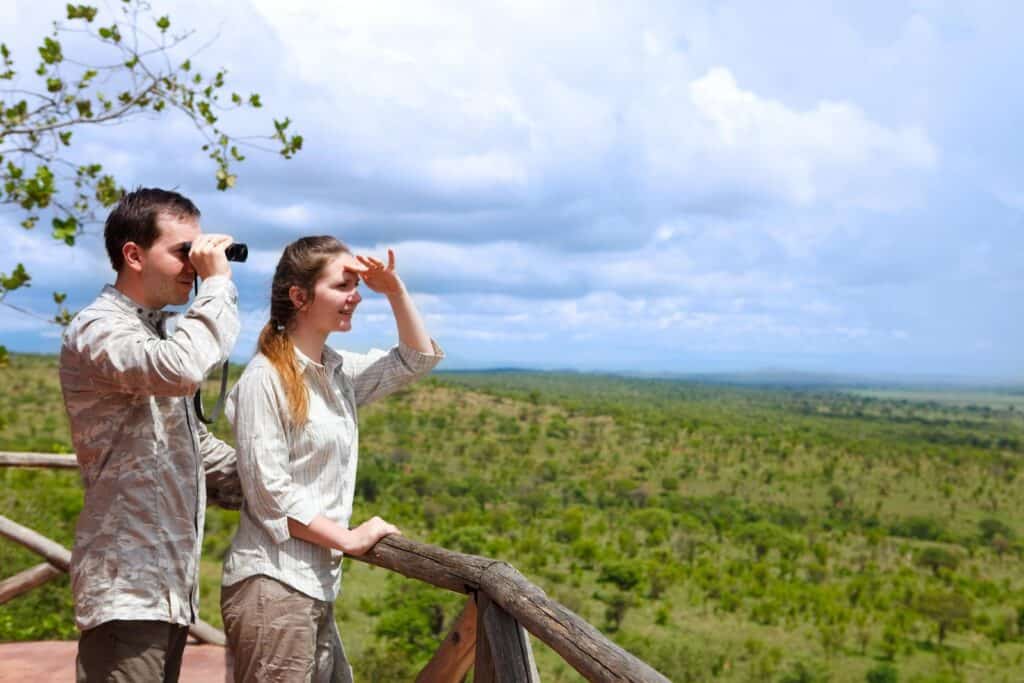
Neutral hues are not just a fashion statement; they are advised to avoid unwanted attention from wildlife and to blend seamlessly with the natural environment.
Footwear and accessories also play an essential role in your safari experience. Durable, comfortable shoes are a must for those long treks, while hats and sunglasses provide necessary protection from the sun.
It’s equally important to dress in layers, as temperatures can vary wildly from sunrise to sunset, and having the option to adjust your attire accordingly will enhance your overall experience.
Key Takeaways:
- Neutral tones in clothing help you blend with the environment and avoid drawing attention from wildlife.
- Comfortable, layered clothing is adaptable to the changing temperatures throughout the day.
- Proper footwear and protective accessories are essential for comfort and safety on safari.
🧳 The Essentials of African Safari Clothes
When you pack for an African safari, the right clothing can make your adventure comfortable and enjoyable. Here’s what you need to know to choose wisely.
🔍 Key Factors for Choosing African Safari Clothes
🌤️ Weather and Duration
You’ll experience a range of weather, so pack layers. Aim for three to four outfits for the typical safari.
Your stay and activities will guide what and how much to pack. Longer trips need durable clothing.
🎒 Functionality
Aim for clothes that protect you from the sun and insects. Pockets can be very handy and are highly recommended for outfits.
Look for clothing that’s quick to wash and dries fast.
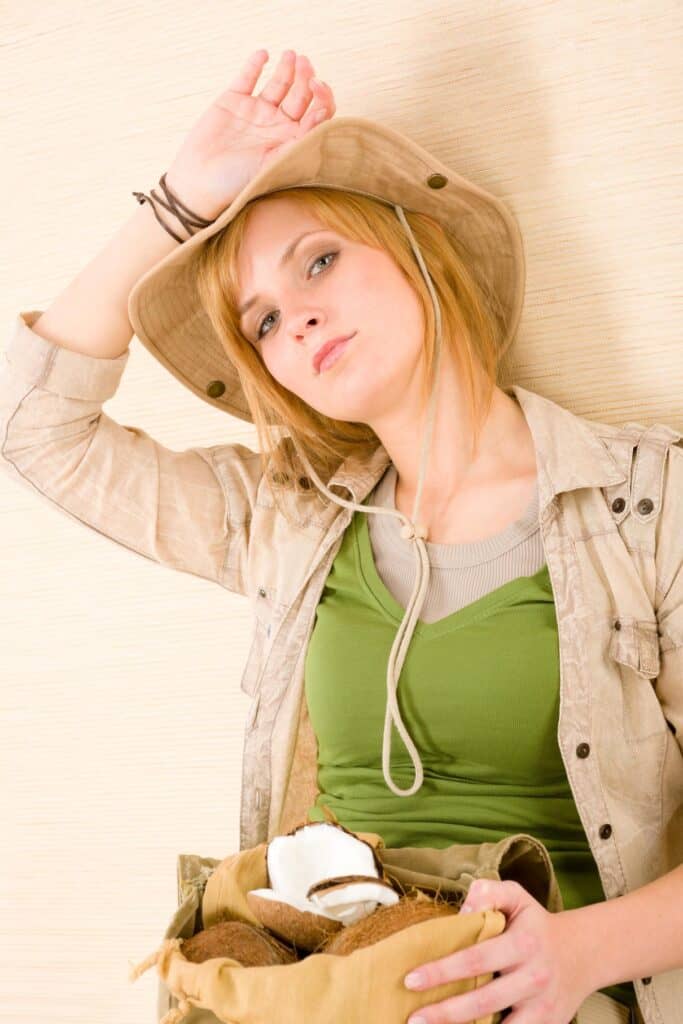
🎨 The Role of Colors in African Safari Clothes
🌿 Blend with Nature
Choose colors that mimic the environment. Khaki, olive, and brown are a good choice for an African safari. These colors help you blend in and are less likely to attract bugs.
❌ Avoid Bright and Dark
Stay away from bright colors and very dark shades. Bright colours may disturb wildlife, while tough dark fabrics can get too hot and attract insects.
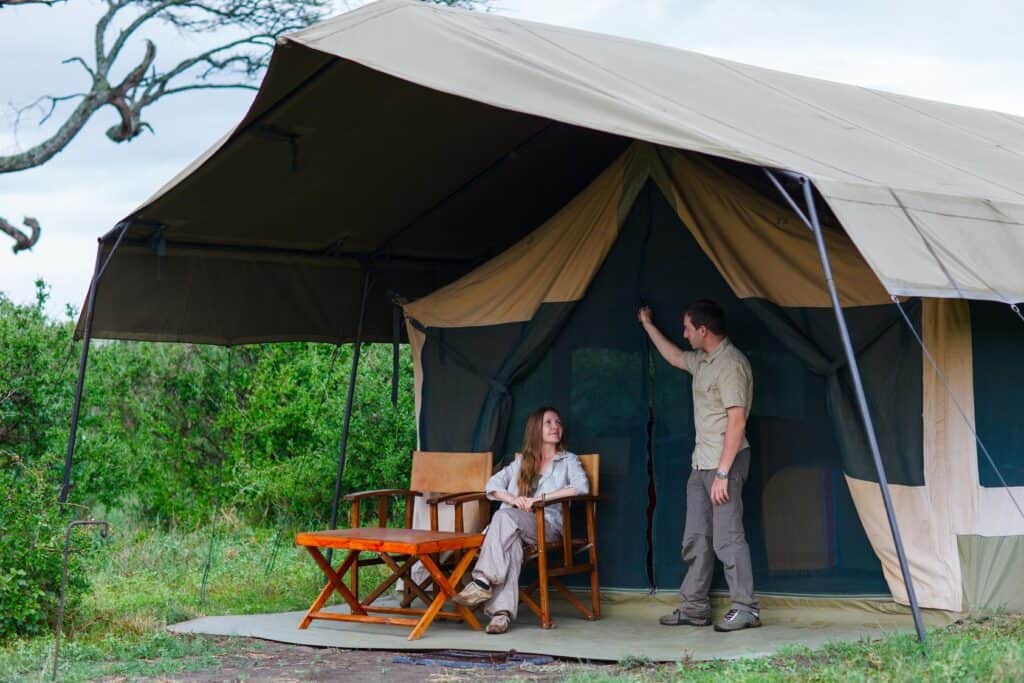
❌ Choosing African Safari Clothes: Material Considerations for Comfort and Safety
💨 Breathable Fabrics
Choose materials like lightweight cotton or linen. They keep you cool and wick away moisture.
🚶♂️ Long Sleeves and Trousers
These are essential to protect you from the sun and bug bites. They should be comfortable to allow easy movement.
Your safari clothing is more than just fashion. It’s your first layer of protection and comfort. Choose well, and you’re in for an amazing and comfortable adventure!
🎨 The Significance of Neutral Colors in African Safari Clothes
When preparing for an African safari, choosing the right colors is crucial for your comfort and experience.
Here’s a look at why bright and dark colors aren’t ideal and what hues are recommended for different regions.
❌ Avoiding Bright and Dark Colors
Bright colors, such as whites or neons, can be startling to wildlife and may hinder your ability to see animals in their natural habitats. They’re also prone to getting dirty quickly. Dark colors, particularly black and dark blue, should be avoided as they can attract tsetse flies, which are common in some African regions and are known to bite.
🌍 Ideal Color Choices for Different Safari Regions
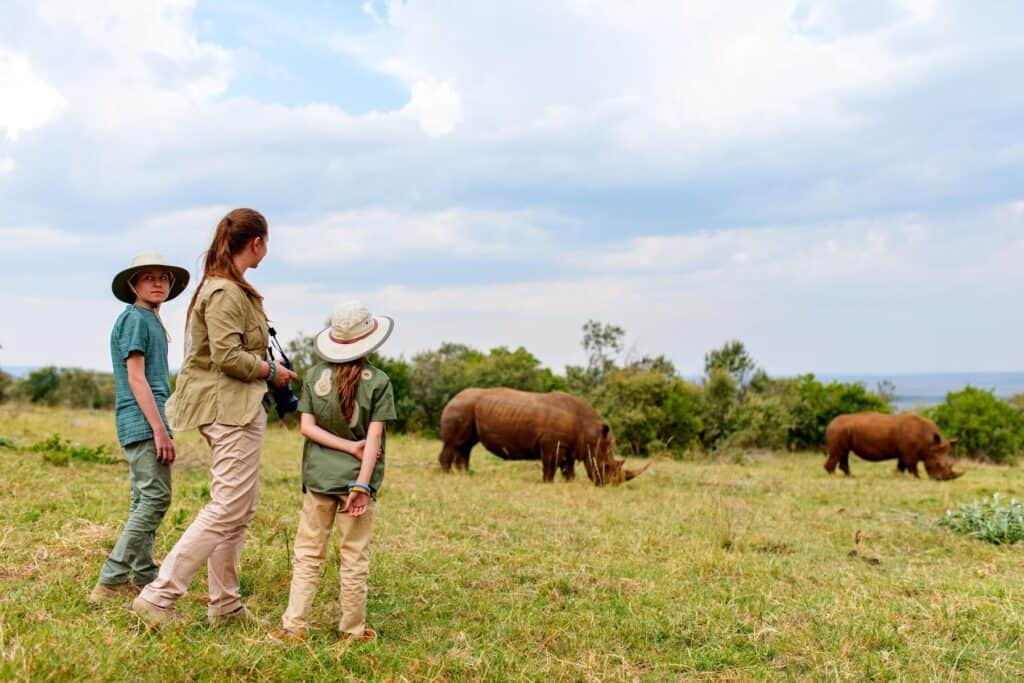
For a safari in South Africa and most safari areas, stick to a palette of neutral colours: khaki, olive, tan, and light brown. These shades blend in with the environment, improving your chances of observing wildlife without disturbance.
- Khaki and light brown: These colors are less likely to show dust and dirt.
- Olive and green: Perfect for forested areas, they match the foliage.
Remember, your clothing choice is not just about fashion; it’s about practicality and respect for the environment you’re in.
👕 Men’s Guide to African Safari Clothes
Before you set foot on the savannah, be sure your gear is up to the task. Your comfort, safety, and even your enjoyment can hinge on having the right safari clothes.
👕 African Safari Clothes: Top Picks for Safari Shirts and Pants
👚 Safari Shirts
- Material: Look for lightweight, breathable fabrics such as moisture-wicking materials to stay cool under the hot African sun.
- Color: Stick with beige or other neutral tones are the perfect choice to blend with the environment.
- Features: Long sleeves offer added protection against the sun and insects.
👕 Safari Pants
- Fit: Choose pants that are comfortable for long drives in a safari vehicle, and that allow ease of movement.
- Durability: Select robust fabrics that resist tearing on branches or rocks.

🧥 African Safari Clothes: Jackets and Accessories for Men
🧣 Safari Jackets for Men
- Insulation: A warm fleece jacket is essential during the cold season.
- Protection: Consider a jacket with ample pocket space for carrying essentials.
🧣 Accessories for Men
- Hats: A wide-brim safari hat or a baseball cap is crucial for sun protection.
- Footwear: Pack a pair of quality sandals or flip-flops for lounging at the lodge and sturdy shoes for time spent in the wild.
👗 Women’s African Safari Clothes
When heading out on an African safari, choosing the right clothes is key. You want pieces that combine style with practicality while keeping you comfortable and protected.
💃 African Safari Clothes: Combining Style and Practicality
Your safari wardrobe should focus on neutral colors to blend in with the natural environment.
Lightweight and breathable fabrics are essential to keep you cool under the African sun.
Look for UPF-rated clothing to protect your skin from the sun’s rays.
A popular choice is long-sleeve shirts made with recycled nylon or polyester, as it’s both eco-friendly and comfortable.
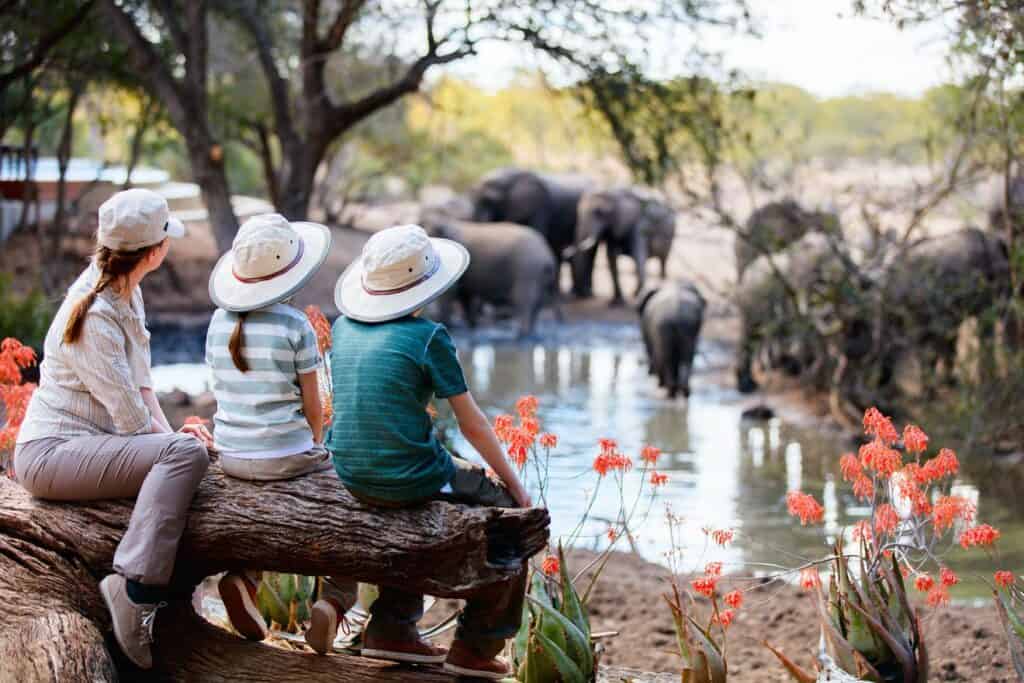
Here’s a brief rundown:
- Shirts: Choose lightweight, breathable ones with a UPF 40+ rating.
- Trousers: Opt for convertible cargo pants that can turn into shorts.
- Jackets: A warm fleece top for chilly mornings and a waterproof jacket for unexpected rain.
👢 African Safari Clothes: Footwear and Accessories
Your feet need to be well taken care of, so safari boots designed for walking are a must-have.
They should be well-fitting, durable, and provide good ankle support.
As for accessories, a wide-brim hat can protect your face from the sun, and a high-quality pair of sunglasses will keep the glare out of your eyes.

Here’s a simple list of must-haves:
- Boots: Comfortable, supportive, and preferably water-resistant.
- Hat: A wide-brim option for sun protection.
- Sunglasses: Ensure they offer 100% UV protection.
Remember, good looks come with choosing the right clothing that won’t just serve the purpose but will also make you feel good about your outfit choice.
And don’t forget about a sturdy leather belt to tie your safari look together.
🐜 Protective Safari Gear Against Insects
When you’re on a safari, protecting yourself from insect bites is crucial. Your clothes can play a big role in keeping bugs at bay.
🦟 Choosing African Safari Clothes for Bug Repellence
To stay bite-free, pick clothes smartly. Go for the following:
- Colors: Light, neutral tones like khaki, beige, or olive. These shades are less appealing to insects.
- Materials: Breathable, lightweight fabric that is tightly woven fabrics that prevent tsetse flies and mosquito bites.
🛡️ Additional Measures for Insect Protection
Aside from clothes, use these tips to ramp up your defense:
- Insect Repellent: Apply a good repellent on exposed skin and over your clothing.
- Layers: Wear long-sleeved shirts and long pants, tucking your pants into your socks when you can (Sounds nerdy but trust me, you’ll thank me for it, lol).

🌦️ Safari Clothing for Different Seasons
When planning your safari wardrobe, choosing the best time of year is critical. You’ll want to pack for comfort, whether it’s the dry season or the rainy season.
☀️ Dressing for the Dry and Rainy Seasons
🌞 Dry Season
Typically, the dry season brings hot days and cooler evenings. Your daytime attire should include lightweight, breathable fabrics. Khaki, beige, taupe, or grey are great choices as they don’t attract insects and blend with the surroundings.
Here’s a quick list for the dry season:
- T-shirts or vests: 4
- Safari pants or shorts: 4
- Blister-proof socks: 4 pairs
- Warm fleece: for the cooler evenings (2 tops)
🌧️ Rainy Season
The rain brings lush landscapes but also mud and muck. You’ll want waterproof gear and layers that dry quickly. Don’t forget a sturdy rain jacket and water-resistant shoes.
Here’s your rainy season gear:
- Waterproof jacket: 1
- Quick-dry shirts: 3 short-sleeve
- Quick-dry pants: 2-3 pairs
- Waterproof boots: 1 pair
🌅 Layering for Early Mornings and Evenings
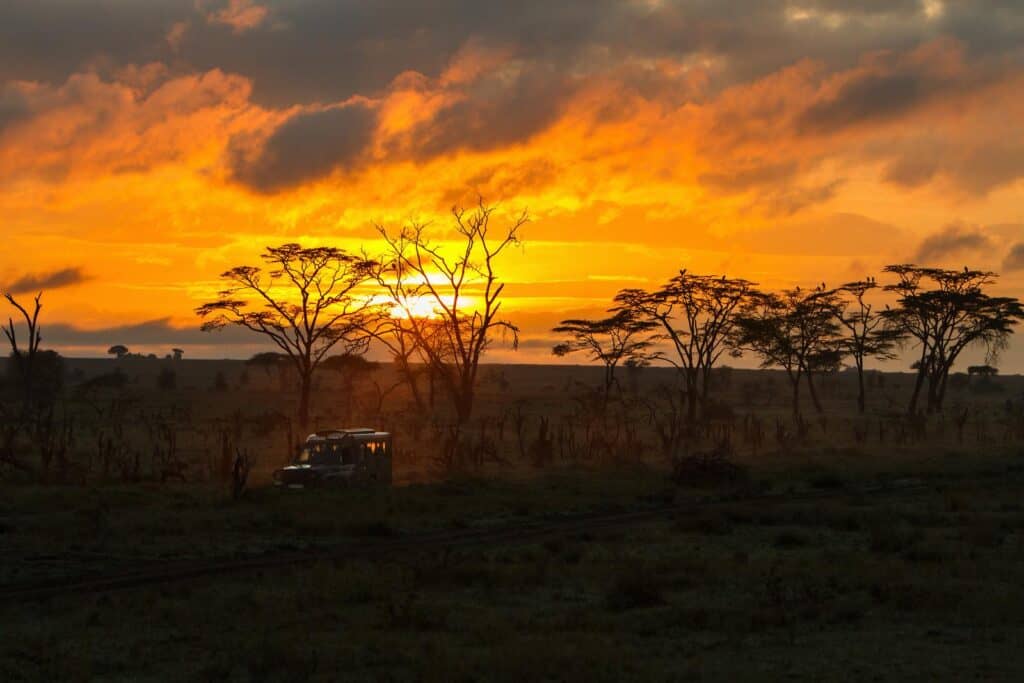
In the mornings and evenings on safari, temperatures can drop, and it’s often much cooler. You should consider a warm jacket that’s versatile enough to shed when temperatures rise throughout the day. Look for fleece or a soft-shell jacket—they’re light but warm.
For evenings, regardless of the season, a warmer layer is essential. It’s nice to have a comfortable, warm jacket for dinner by the fire or while winding down from your adventure.
Keep in mind:
- Early Morning: Start with a base layer like a long-sleeve shirt, and add a fleece or jacket.
- Evening Wear: Have a warm jacket and consider layer-friendly options, such as cardigans or pullovers.
🧳 Practical Tips for Safari Packing
Packing for an African safari is all about balancing what you need with weight restrictions, particularly if you’re flying on small planes to reach your destinations. Let’s break down how to craft your packing list and manage luggage weight effectively.
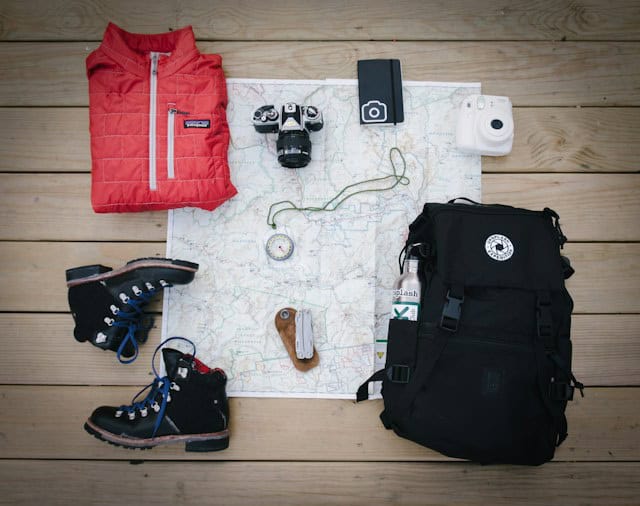
📝 Creating an Efficient Safari Packing List
Your safari packing list should include lightweight, breathable clothing in neutral colors. These colors are best as they blend with the environment and don’t attract insects as much as brighter shades.
- T-shirts – Bring about four, in earth tones.
- Pants/Shorts – Four pairs, preferably those that convert easily from pants to shorts.
- Socks – Pack several pairs of blister-proof socks for walks.
- Outerwear – Include a couple of warm fleece tops or jackets, depending on the season.
Aim to pack clothing that is multipurpose, saving space and maximizing utility.
Remember, on safari, comfort is king, so choose items that offer flexibility and protection from the elements.
📝 Luggage Restrictions and How to Pack Light

Many safaris involve travel on small planes, which have strict weight limits for luggage.
Typically, you may be restricted to 15-20 kilograms (33-44 pounds), and soft-sided bags are preferred as they fit better in the aircraft.
- Safari Bag – A duffel or soft-sided bag will meet most airline requirements.
- Packing Technique – Use packing cubes or plastic bags to organize and compress your items.
- Utilities – Remember to bring a TSA-approved clear toiletry case.
To keep your load light, wear your bulkiest items on the plane. Heavy boots and a jacket don’t need to take up space in your bag if they’re on you.
Remember, your safari adventure will likely include laundry services, so you can re-wear clothes. Pack light and enjoy more freedom!
👞 Footwear and Accessories for the Safari
When heading out on a safari, picking the right footwear and accessories can make all the difference. It’s not just about style; it’s about comfort and safety among the wild animals and varying terrains you’ll encounter.
🥾 Selecting the Best Safari Boots
You’ll need sturdy boots for your safari. Look for closed-toe walking boots that are tough enough to protect your feet from bites and scratches.
Hiking boots are a solid choice—they give good ankle support and grip for walking on uneven ground.
Keep in mind that boots should also be well-ventilated to keep your feet cool.
🎒 Must-Have Safari Accessories
For the rest of your gear, be smart about what you pack.
Safari hats are not just fashionable—they shield you from the harsh sun. Go for wide-brim hats; they give better coverage than baseball caps.

Safari shorts are great for hot days, but remember to pack something longer for the evenings when the mosquitoes come out.
- Sunglasses: Protect your eyes with a good pair.
- Light Scarf or Bandana: These can cover your neck or face when it gets dusty.
- Binoculars: A must for wildlife spotting without getting too close.
Good accessories can transform your experience, ensuring you’re prepped for both the high noon sun and the close encounters with nature.
🏞️ Choosing Safari Outfits by Activity Type
When heading out on a safari, your comfort and ability to engage with the environment depends a lot on what you wear. Here’s how to choose the right outfit for different safari activities.
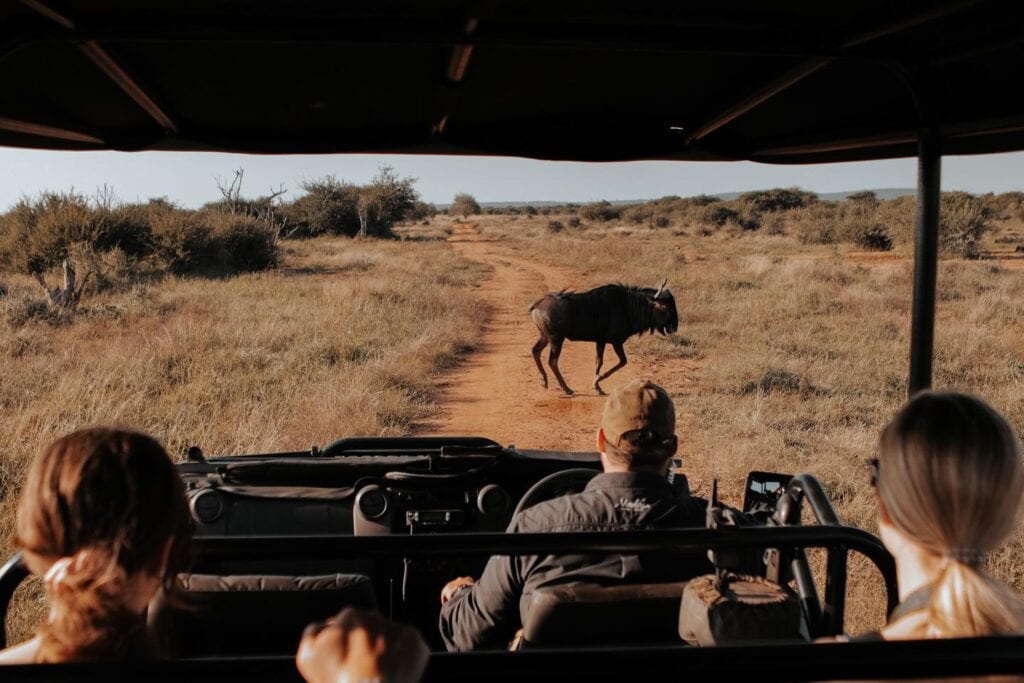
🚗 Clothes for Game Drives and Walking Safaris
🦒 Game Drives
When you’re on a game drive, always go for layers. Start with a breathable, long-sleeve shirt to protect your skin from the sun and brush. Pair it with lightweight, long pants.
- Top: Long-sleeve shirt (neutral colors)
- Bottom: Lightweight pants (neutral colors)
- Shoes: Sturdy closed-toe footwear
- Accessories: Wide-brim hat, sunglasses, and a scarf or bandana
🚶♀️ Walking Safaris

If you’re on a walking safari, durability and comfort are key.
- Top: Quick-dry material shirt
- Bottom: Durable, khaki or olive-colored shorts or pants
- Shoes: Hiking boots
- Accessories: Binoculars strap, breathable hat
🏕️ Safari Camp Attire and Leisure Wear
🛖 Safari Camps
Being at the camp is your chance to relax. Opt for casual, comfy clothes. It’s fine to wear shorts, t-shirts, or lightweight dresses.
- Morning and Evening: Fleece or light jacket for chillier times
- Daytime: T-shirts, shorts or light dress
- Shoes: Sandals or flip-flops
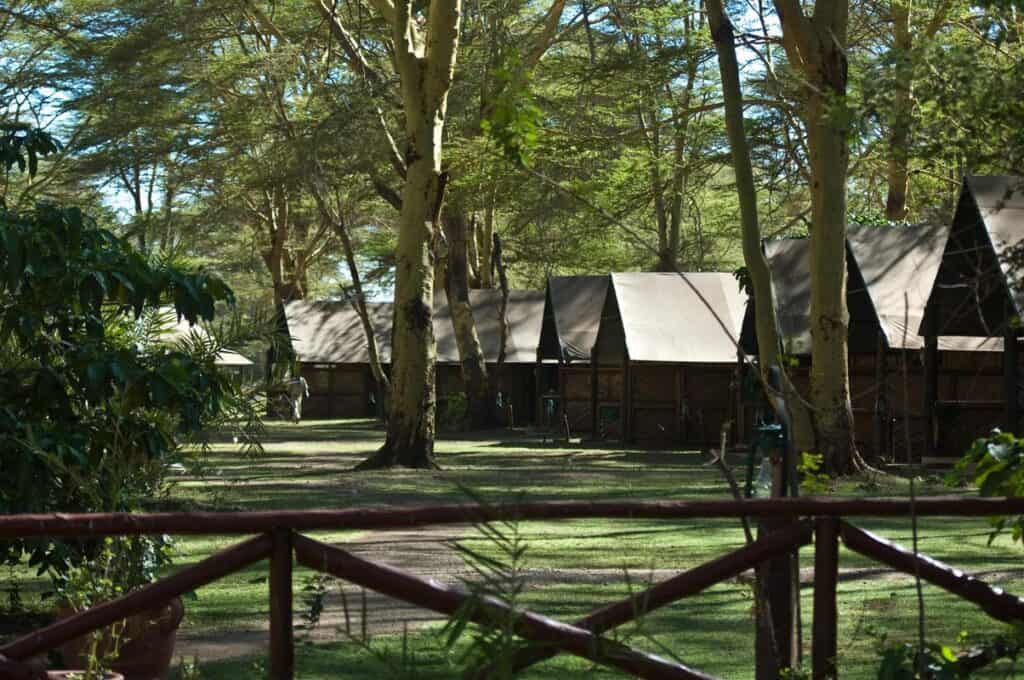
👙 Bathing Suit
Be sure to pack a bathing suit. Some camps offer pools that are perfect for a cool dip after a day of game viewing.
- Materials: Quick-dry fabric
Keeping these specific outfits in mind will help you enjoy each aspect of your safari, from the thrill of game drives to the relaxation at your camp.
📚 Advice from Safari Experts
When heading on a safari, expert advice can make all the difference in your experience and enjoyment. Here’s what we recommend.
🌐 Outfit Selection Based on Destination Insight
Cape Town and surrounding safari southern Africa destinations may have varying climates. Before packing, it’s crucial you research your specific destination. Here’s what we recommend:
- Lightweight clothing: For hot days under the African sun.
- Moisture-wicking fabric: To keep you dry and comfortable.
- Neutral colors: Blending in with the environment is key.
Protection is paramount: Consider long sleeves and pants for sun and insect defense.
👔 Professional Guidance on Safari Dress Code
Safari dress code isn’t just about style—it’s functional. We recommend the following:
- Layering your clothing: Temperatures can change drastically from day to night.
- Durable footwear: Closed-toed shoes are a must for treks and rugged terrain.
Accessories matter: A wide-brim hat for sun protection and sunglasses are essentials on your packing list.
❓ Frequently Asked Questions
Before heading out on a safari, you might have questions about what to wear. These answers will help you pack the right gear to ensure a comfortable adventure.
🧢 What should you wear to an African safari?
For your African safari, choose neutral earth colors. Clothes in khaki, beige, brown, and olive help you blend with nature. You’ll want light, breathable fabrics. Don’t forget a wide-brimmed hat for sun protection and sunglasses that offer 100% UV protection.
🏷️ Which are the best brands for safari clothing?
The best brands for safari clothing combine comfort with outdoor technology. Look for brands that offer durability, comfort, and protection from the elements. Some well-known brands include The North Face, Patagonia, and Columbia.
🛒 Where can you purchase appropriate safari attire?
You can find safari clothing at outdoor retailers or specialized travel clothing stores. Many brands are also available online, allowing you to compare options and shop for the best gear from home.
👖 Are jeans suitable for wearing on a safari adventure?
Jeans are typically NOT recommended for safaris. They’re heavy and don’t dry quickly if they get wet. Instead, opt for lighter pants that are made for outdoor activities.
🧥 What are the recommended clothing options for women on an African safari?
Women on safari should pack lightweight and comfortable clothing. Think breathable tops, long-sleeved shirts for protection, and versatile pants or skirts.
A safari dress can be a comfortable option for time at the lodge.
👕 What kind of clothes should men pack for a safari trip?
Men should pack lightweight, breathable shirts and durable pants. A good pair of safari boots is essential for bushwalks. Pack a hat and consider a light jacket for cooler mornings or evenings.
